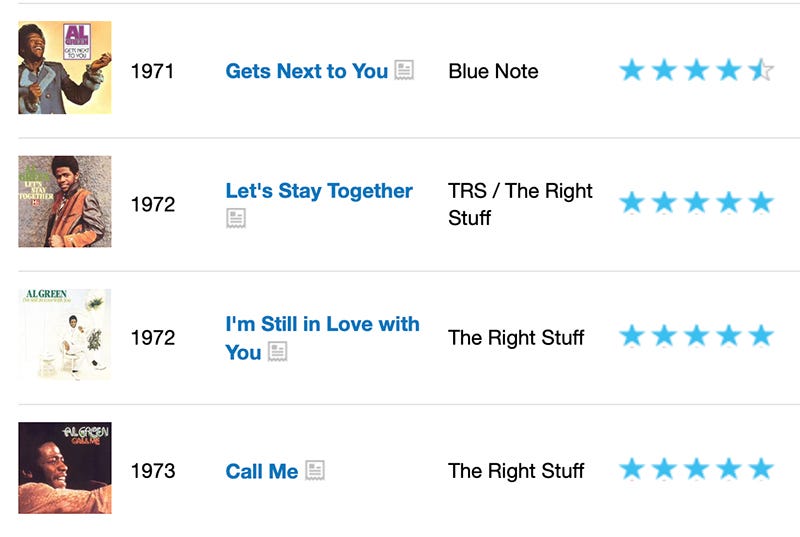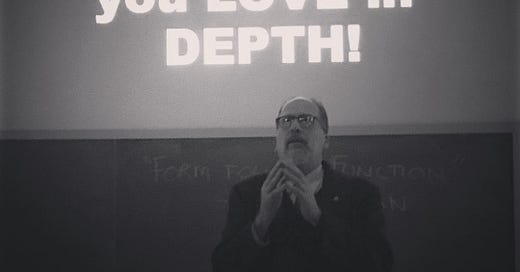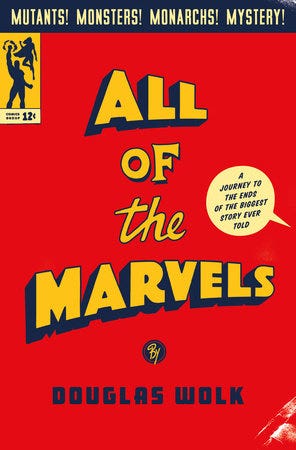Study something you love in depth!
A pandemic project: working your way through a favorite artist’s back catalog
Hey y’all,
Five years ago this week, I attended a Paul Karasik lecture about his book, How To Read Nancy. Karasik spoke of what he learned from writing a full-length book about a single 3-panel strip that cartoonist Wally Wood once joked is easier to read than to not read.

Here is the message he ended with: “Study something you love in depth.”
“Here’s the only thing you need to remember from this talk: ‘Study something you love to death’—I mean ‘depth’! [laughter] ‘Study something you love in depth.’ I just gave you an hour, so tonight give me 45 minutes. Spend 45 minutes tonight studying something you love. Watch the first five minutes of your favorite movie 7 times. You will notice new things.”
As I wrote Steal Like an Artist, “Go deeper than anybody else—that’s how you’ll get ahead.”

One way to do this is by thinking of lineage, or climbing your own family tree:
Marcel Duchamp said, “I don’t believe in art. I believe in artists.” This is actually a pretty good method for studying—if you try to devour the history of your discipline all at once, you’ll choke.
Instead, chew on one thinker—writer, artist, activist, role model—you really love. Study everything there is to know about that thinker. Then find three people that thinker loved, and find out everything about them. Repeat this as many times as you can. Climb up the tree as far as you can go.
But what’s the best way to work your way through the back catalog of an artist you love?
I see at least two options for such time-traveling:
Chronological or reverse-chronological. Starting at the beginning and moving forward, or starting with the artist’s most recent work and moving backwards.
Zigging and zagging. Starting with your favorite “hot spot” and working outwards, leaping and jumping or skipping to what seems interesting.

I recently asked writer and filmmaker Kevin Smokler (of Vinyl Nation) to write about his project of “listening through” a favorite musician’s discography. Kevin does these “listen throughs” in chronological order, because that “renders the clearest picture of where an artists sound began and where it ended up.” But he also says he thinks zigging and zagging is “equally valuable.”
In a wonderful comment, reader Joe R. pointed me to critic Douglas Wolk’s book, All of the Marvels, in which Wolk read every comic Marvel has published since 1961 — over 27,000 issues. Wolk explicitly warns readers against reading chronological reading:
I did not, however, read six decades of stories in order. That would have been unbearable – and it is one of the two mistakes Marvel-curious readers often make. It is a surefire route to boredom and frustration as the fun lies in following your whims. The other error is trying to cherrypick the greatest hits, the pivotal single issues. Taken in isolation, these are peaks without mountain ranges. Their dramatic power comes from their context… Instead, I would go grazing, looking at whatever seemed most fun that day…
Joe also pointed to the AV Club’s “Primer” feature, as a great way to get up to speed on an artist’s output. (See, for example, their 101 on Neil Young or cartoonist Jack Kirby, somebody whose catalog I’ve wanted to dive into for a long time but have found very difficult to crack.)

I suspect the approach to an artist’s back catalog depends on the artist. Charles Portis, for example, is the only novelist whose books I’ve read through twice, and I think he’s ripe for a chronological read: he only published 5 novels and he took his time in between them. Norwood is quite short and easy to get through, True Grit is his classic, Dog of the South might be his best, Masters of Atlantis is his weirdest, and Gringos is my favorite.
Thoreau, on the other hand, well, I’ve never actually finished Walden or any of the books he published in his lifetime! But his (abridged) diary has been an enormous influence on me, and I read it in a very specific “on this day” way: keeping post-it tabs for the current date on each year he wrote, and reading it every day, looping myself over a few years. (In the case of Thoreau’s biographer, Robert D. Richardson, I did a deep dive by reading his Thoreau/Emerson/James trilogy.)
There are two artists I’m thinking about for my own “listen through” project: Cocteau Twins and Kate Bush. Both made records that I love so much — Heaven or Las Vegas and Hounds of Love, respectively — that I haven’t been able to branch out much into their discography. I suspect the zig/zag approach might be best for both of them, as their sound in the beginning is much different than where they ended up.


I wanted to wrap up these thoughts by highlighting a few listen-through, play-through, watch-through, read-through, etc. projects off the top of my head, to give you an idea of the creative possibilities of such a project:
Warren Craghead’s Sun Ra Spring. Warren, who is one of my all-time favorite drawers, is listening to all 110 Sun Ra albums on Bandcamp, drawing while listening, then writing about them. This is wildly ambitious, but Warren is used to such projects. (I love the idea of making art while listening and I am going to steal it.)
Andy Baio’s Playing With My Son. Andy played through video game history with his son Eliot in chronological order. Starting with Pac-Man, then moving on to old Atari 2600 games, then the 8-bit games of the NES era, and so on. Andy says he “gave my son a crash course in video game history, compressing 25 years of gaming history into about four years.”
James Francis Flynn’s watchthrough of WGA’s 101 Best Screenplays. Over fifteen years ago (!!!) my filmmaker friend decided to watch every movie on the WGA’s 101 best screenplays list and blogged about each one. Another wildly ambitious project that took him six years to finish, but it was so fun reading along. Basically a film school in itself.
The Julie/Julia Project. Blogger Julie Powell cooked every single recipe in Julia Child’s Mastering the Art of French Cooking, then got a book deal and published a bestselling book about it, which was then made into a delightful comedy by Nora Ephron. (This came to mind after my wife Meg sent me Hannah Goldfield’s recent New Yorker piece about making her way “Julie & Julia’ style” through her new favorite cookbook.)
Sean T. Collins’ Pain Don’t Hurt: Meditations on Road House. Not a watchthrough, exactly, but a perfect example of “study something you love in depth.” Collins once tweeted, “I could write about Road House every day for a year and never run out of things to say about it.” And then he did it.
It occurs to me that there are some great Show Your Work! style lessons that run through a lot of these projects:
Learn in public! When you commit to learning something in public, you end up teaching others. Almost every young artist who writes to me, or any artist who is trying to build an audience, I tell them to do this kind of project in public as a way of being valuable to and gathering the kind of people they want to see their own work.
Pick a subject/artist you love that already has an interested audience. Road House, for example, is a perfect cult movie: people like me, who love it, love it a lot. Same goes for Sun Ra. I’m sure Mastering the Art of French Cooking has a cult, too, but it’s also a cultural behemoth that a lot of people know about but might not have actually read.
Do it for the sake of doing it. Like all creative projects, the only guaranteed reward is the doing itself. Focus on the word “love.” Studying something you love in depth, not something you sort of like.
These kinds of projects seem particularly great for a pandemic, as we’re all trying to find something to pull us through our days. Such a project, even a small one, might be something to get you through the winter.
Have you attempted such a project? Do you know of ones that I’ve missed? Tell me in the comments!
Thanks for reading. See you Friday…
Austin
PS. After I wrote this, but before I sent it, my friend Rob Walker sent out his own thoughts on “listening through”!









I have been observing the moon on as daily a basis as I can and marking my observations in my journals. I’m in my 27th year of this practice. At first it was a whim; then an obsession; then an art project; and now a practice, habit; and ritual. I do not do research—strictly personal observation and conversation. I have a scrapbook I’m compiling where I paste in every reference to “moon”, Luna, lunar, lunacy—whatever seems like a moon to me—that I can find, beg, or steal. I’m learning how to teach myself and in the process my ability to observe has really been sharpened. (www.salliewolf.com/moonproject).
This is a fun example: Tiersa watching movies with her cinephile son! https://twitter.com/tiersaj/status/1487542915568214019?s=21